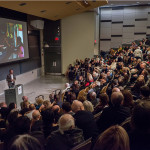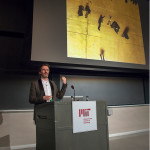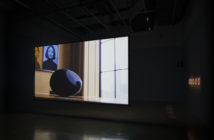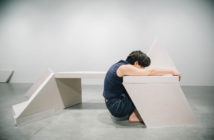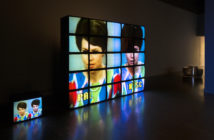During his "Holding Hands with the Sun" public lecture at MIT, Olafur Eliasson commented that "the identity of a city should reflect its people." His claim is manifest in the type of work he makes, in his eagerness to change how public spaces engage the character of individuals and cities alike. Eliasson’s public interventions with projects such as The Parliament of Reality (2009) and The Weather Project (2003), reintroduce public space as a site for engagement and perception. Eliasson’s integration of public space as medium intersects a balance between art and life, technology and nature.
My intention with writing a follow-up to "Through Abstraction We Shape the World" was to continue looking at Olafur Eliasson’s practice and how these two works challenge the identity of a city and the architecture of its people. However, in light of the recent one-year anniversary of the Boston Marathon bombings and being present at this year’s race, my external image of the city has changed.
I’ve lived with the belief that technology has attributed to a fatality in the functionality and understanding of public space. Performance artist and writer Vito Acconci declared the death of public space in 1990 with "Public Space In A Private Time". Like other contemporary scholars, Acconci pinpointed technology as a specific factor in the shift between public versus private. Through social media initiatives such as Twitter, Facebook and Instagram, the virtual landscape made up of what we share and make "public" departs from a physical understanding of space.
The ethereal space controlled by the private individual has changed how we define public. What used to exemplify the public space- the park, the piazza, etc., have existed as dormant geographies, activated and surveyed not by the democratized "public" but by a controlling power. With less and less unity between a public and its spaces, the more we see a decline in the physical gathering place.
While our bodies might be in the public sphere, our minds are deeply rooted in an intangible, digital exchange. The moment we pick up our phones and explore our surroundings through pixelated snapshots, instead of experiencing public space through representation and our senses, we enjoy private time, publically. However, after physically being present in the city of Boston on Marathon Monday, I believe that Acconci’s contention has shifted. While I previously agreed with Acconci that public space has been overthrown by digital meet-ups and ephemeral exchanges, I think that trauma has created a new trajectory of how the people of a city covet public, physical space.
Why trauma? The best way I can explain it is to say that in a jarring moment, words cannot be formed. You question your own reality and your position within a particular moment. It’s a feeling that is different for every individual. A meme or a hash tag cannot describe it. You can only feel. And when you feel, you associate a place that aligns with that memory. The irony is you probably walk through that space and never take notice, assuming its dependability. But when it does, you will crave interaction with it or those you encounter there.
I streamed the 2013 Boston Marathon live from my computer at work. I, like thousands of others, witnessed the marathon attacks through the hyper reality that is digital space. Comments, chat rooms and other forms of contemporary "public space" flooded with accusations and worry. I could not find comfort in the gaze of others in shock or hug those around me. I was isolated in the false sense of communal space that seems like enough when you are collecting meaningless moments of everyday life. I turned my computer off and tried to reach those that I knew were running. In that moment, digital connection was not enough and I couldn’t help by imagine my body running through the finish line and playing what I imagined the traumatic event must have felt like. Naturally, I was unable to feel anything. I could only empathize artificially.
I spent Monday, April 21, 2014 supporting Meghan, my best friend, as she raced her second Boston Marathon. This year, I watched in person. I cheered in Newton at mile 17, stood shoulder to shoulder on the green line with hundreds of strangers and sat on a bench in Boston Common amongst a sea of runners and family members. Collectively, we were active participants in the rebirth of our city’s public space. And, while hash tags and Instagram was still abuzz, the physical presence of Bostonians and beyond filling the streets was unlike any filtered image.
Activating public space through the presence of my body and those of the one million around me triggered this idea that, although a sporting event and not "Art" proper, the bonds that tie us interweave both our mental spirit and physical presence. This compels me to think that on that day the city of Boston re-birthed the so- called "dead public space" Acconci claimed more than twenty years ago.
In all of this, I’m reminded of Eliasson’s practice that reconnects a city and people to its shared spaces. The physical and emotional connection felt by those under the artificial sun of The Weather Project at the Tate Modern turbine was not prompted by trauma or acts of violence. But I do see how the identity of a city can be reinvigorated by the infrastructure of its public space.
Time moved through a linear trajectory in opposition to the hybrid, rhizomatic feed we typically live by day-to-day. The trauma of losing the city’s individuality as Eliasson says leaves its people starving to not only reclaim a physical presence, but also a unified identity.


